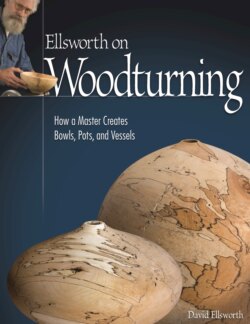Читать книгу Ellsworth on Woodturning - David Ellsworth - Страница 14
На сайте Литреса книга снята с продажи.
Characteristics of wood
ОглавлениеAll wood species have three characteristics in common: mass, tension, and a cellular structure. Understanding the subtle relationship between the three elements will influence every aspect of how you manage and preserve these materials.
Wood does not respond well to extreme changes in temperature or humidity. So, while it’s important to know the wood's condition when you receive it, it is equally important to consider the climate in which you are going to store, and ultimately use, the materials.
You can learn a lot about the inherent tensions in wood by looking at a piece of dried veneer. There is so little mass in the thin veneer that after it is cut from the green log, the natural tensions within the fibers are quickly released via the elasticity of the fibers as they progress from a green to a dry state. The result is a crinkled or rippled surface. A 2"-thick plank from the same tree will have its own tension, but because of its mass, it must be dried carefully to prevent cracking.
Some species of wood are packed with resins (cocobolo) and some seem bone-dry (ash). Some have fibers the size of silk threads (boxwood), while others’ fibers seem like soda straws (cottonwood). Some species will take only a standing finish (lignum vitae), while others will soak up half their weight in oil (poplar). Some contain silica to help dull our tools (eucalyptus), and some cut so finely you hardly have to resharpen (holly). Some trees even come with their own internal support system (above).
Metal rods are commonly used to support the crotch of a tree.
Wood tension
Regardless of how a piece of wood is dried, or how long it has been sitting around, fiber tension remains. This bog oak bowl is a good example of the amount of tension wood retains, even after several thousand years of being buried in a peat bog. Imagine what happens when you take an antique table from Philadelphia to Phoenix. It’s no wonder it opens up.
David Ellsworth, Bog Oak Bowl, 2003. Irish bog oak; 2" high x 7" wide x 5" deep. Tension exists even in this very old piece of bog oak.
